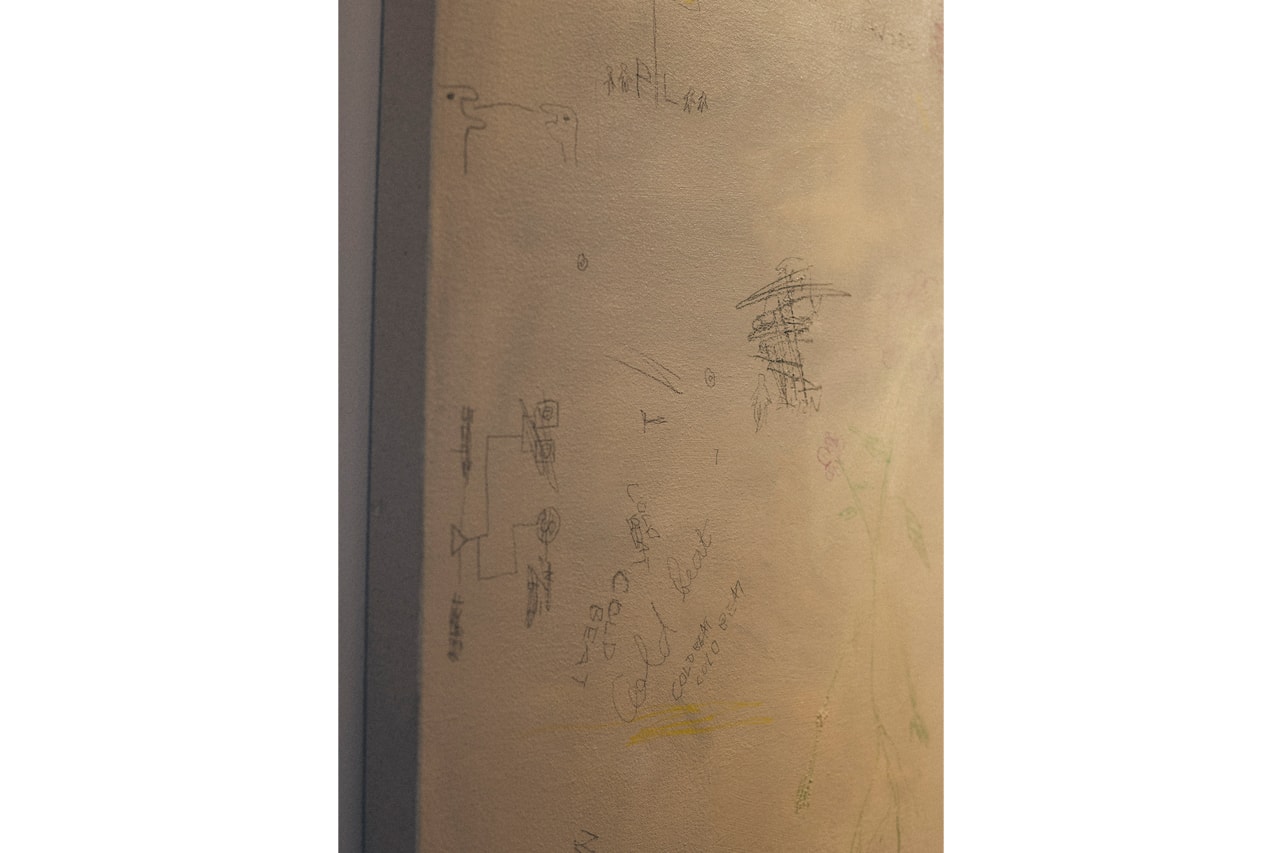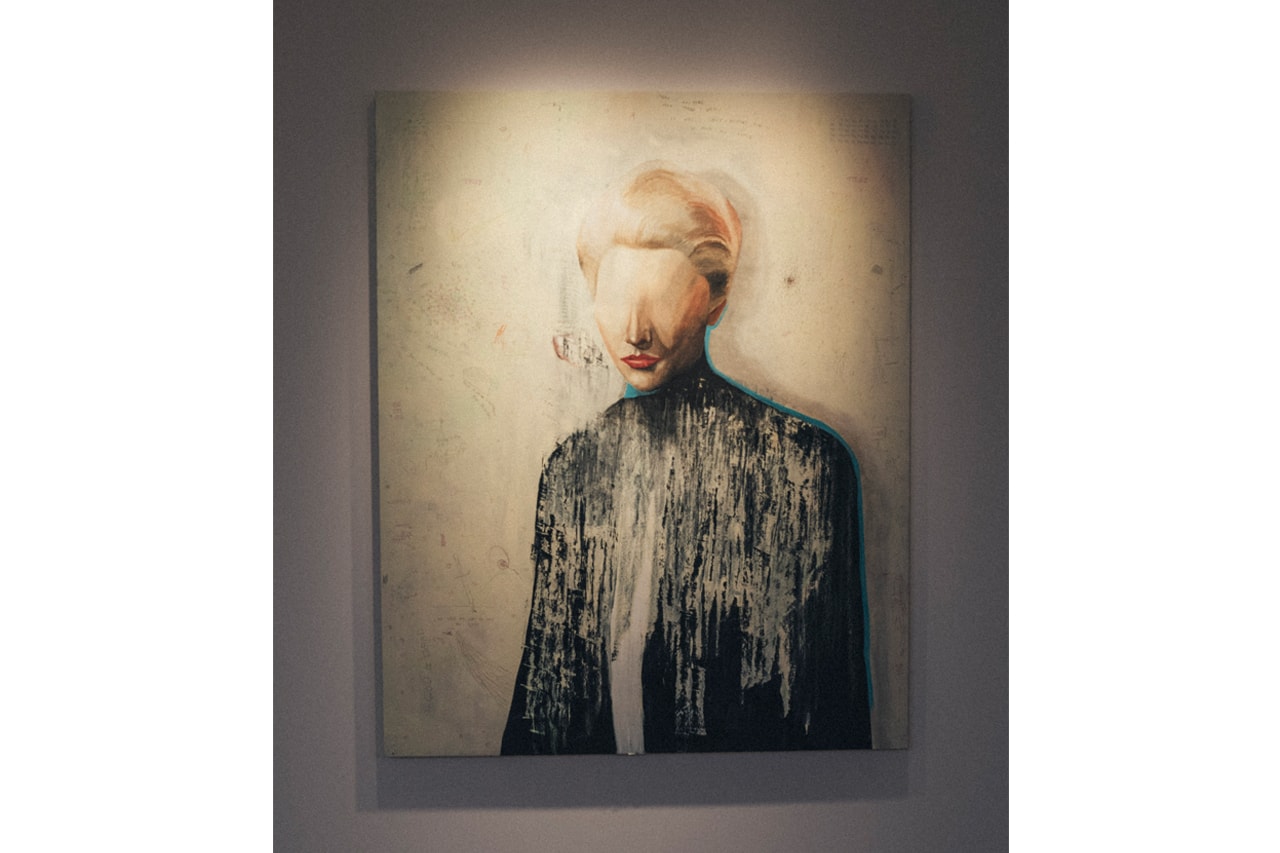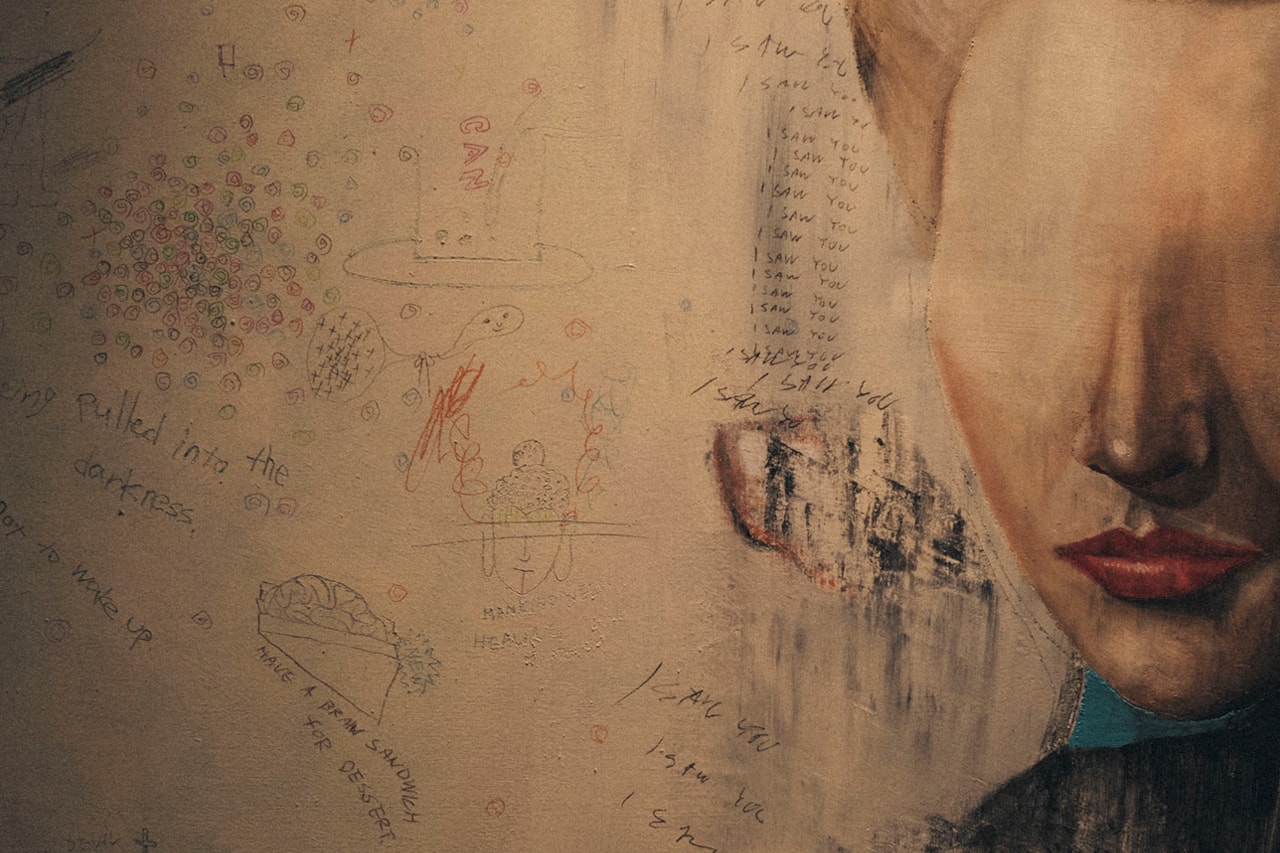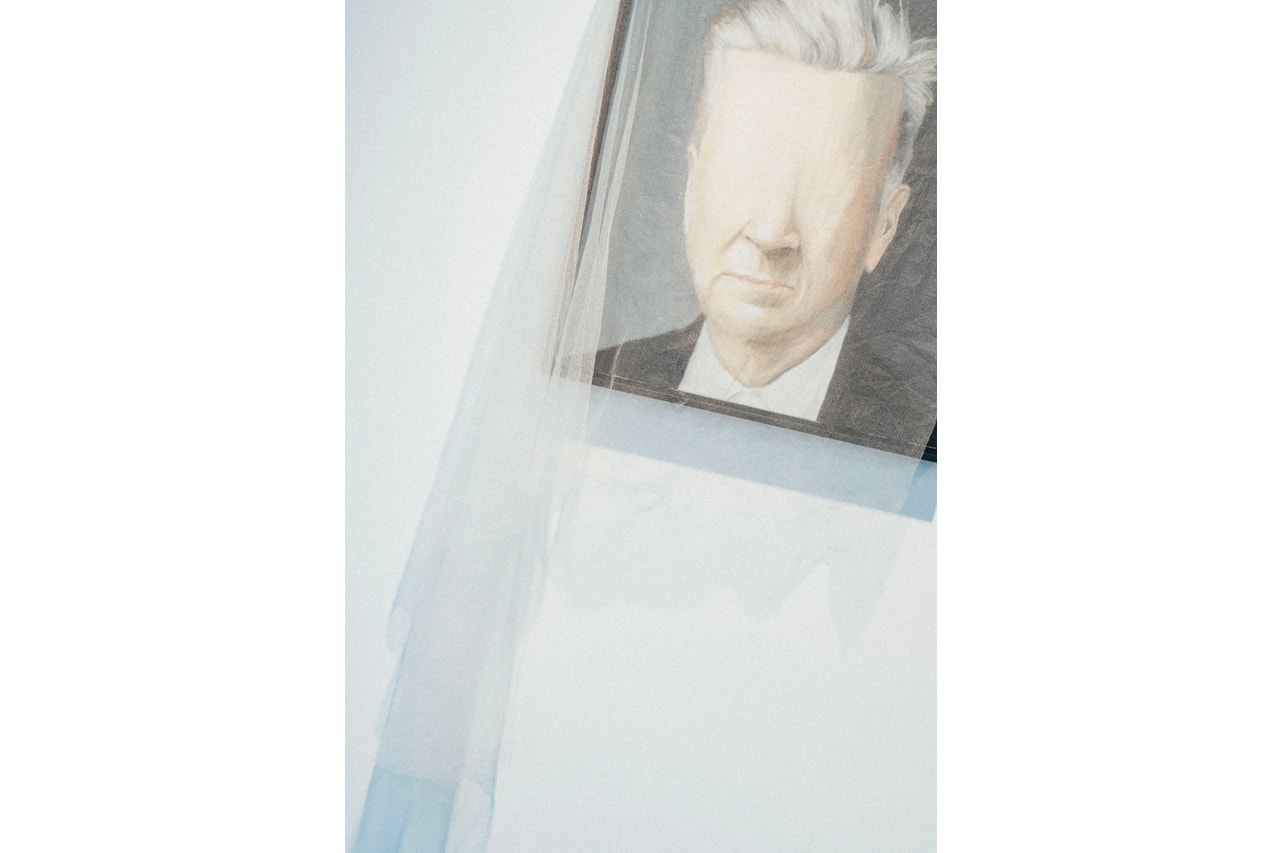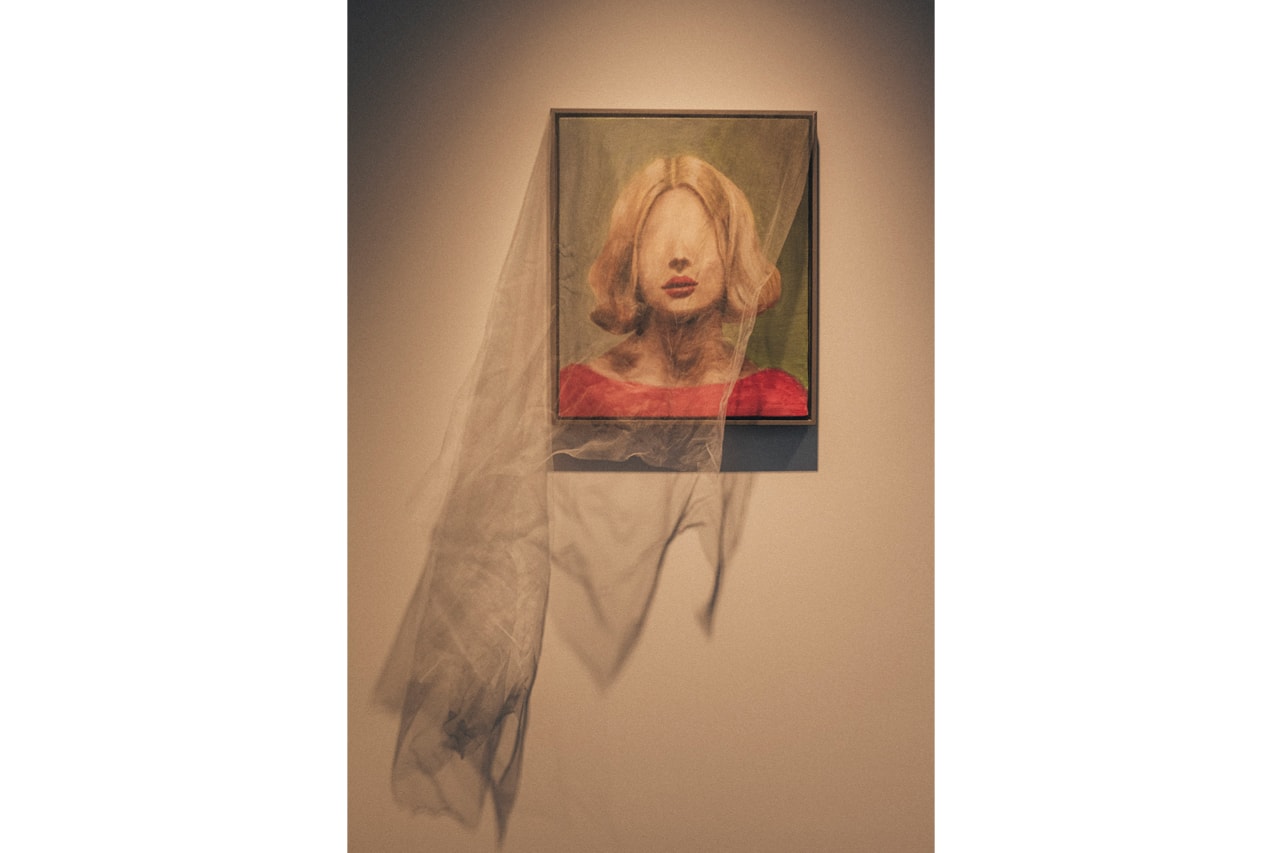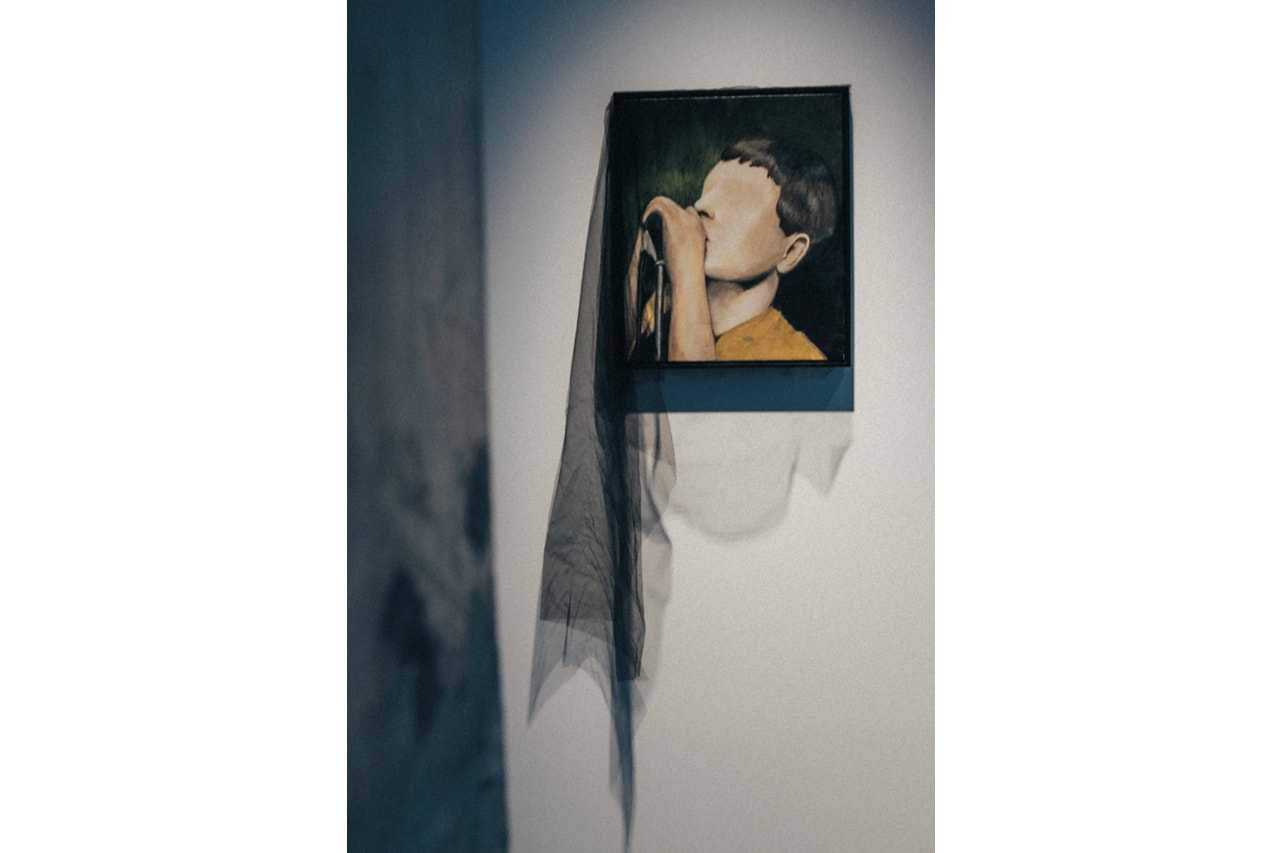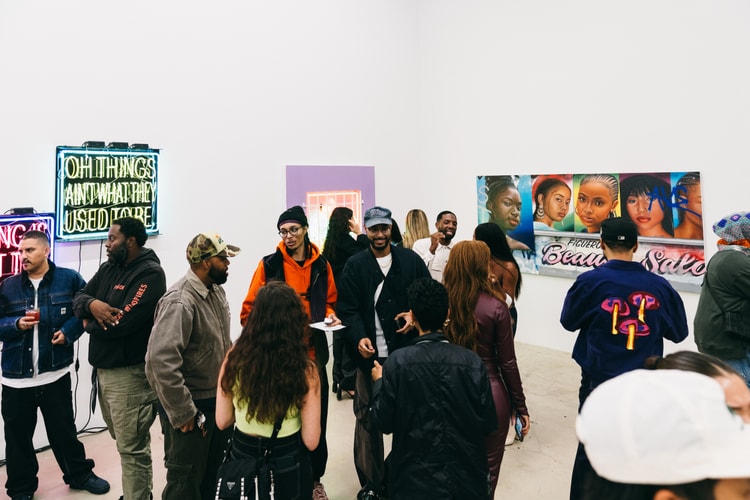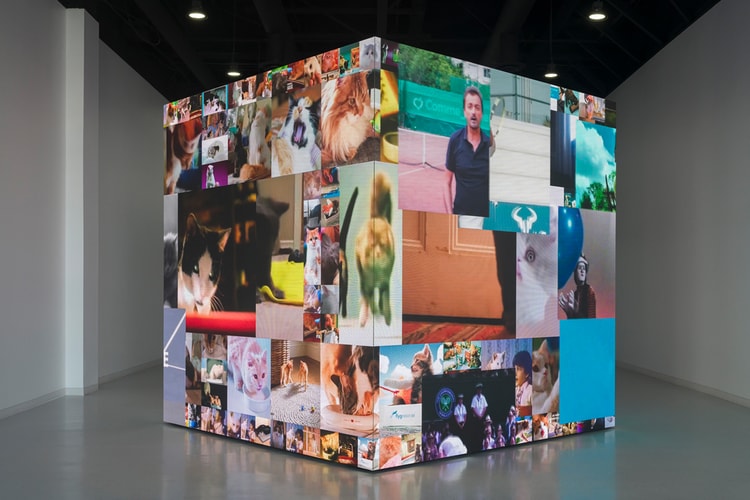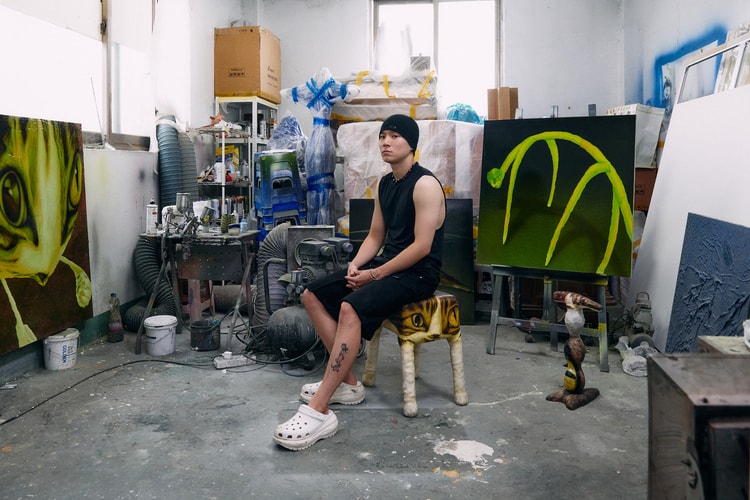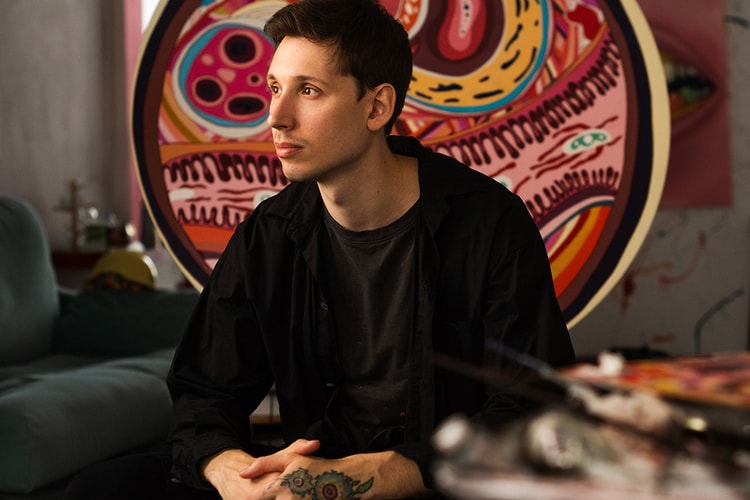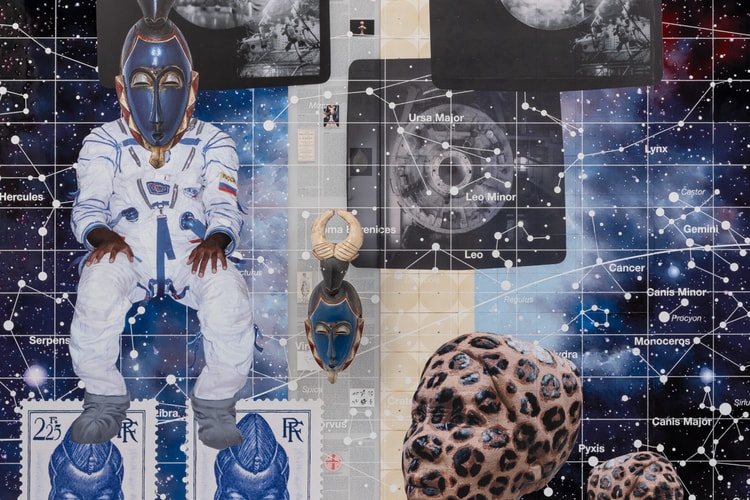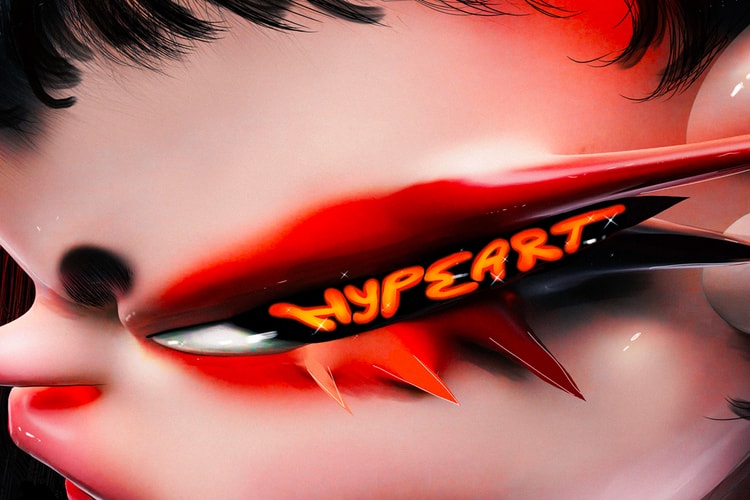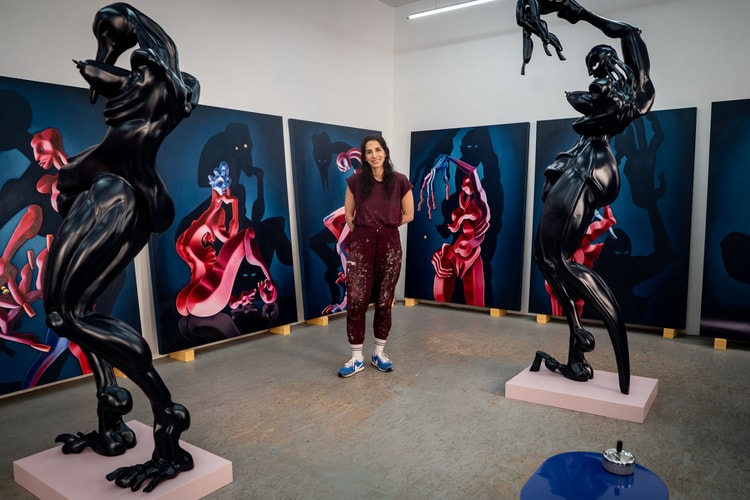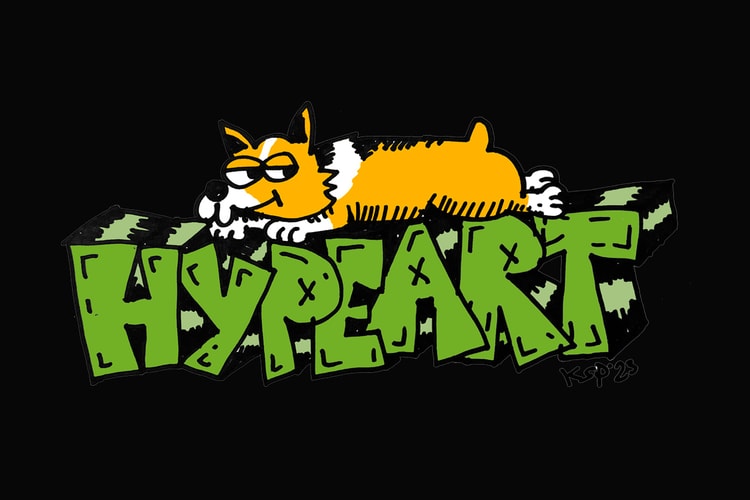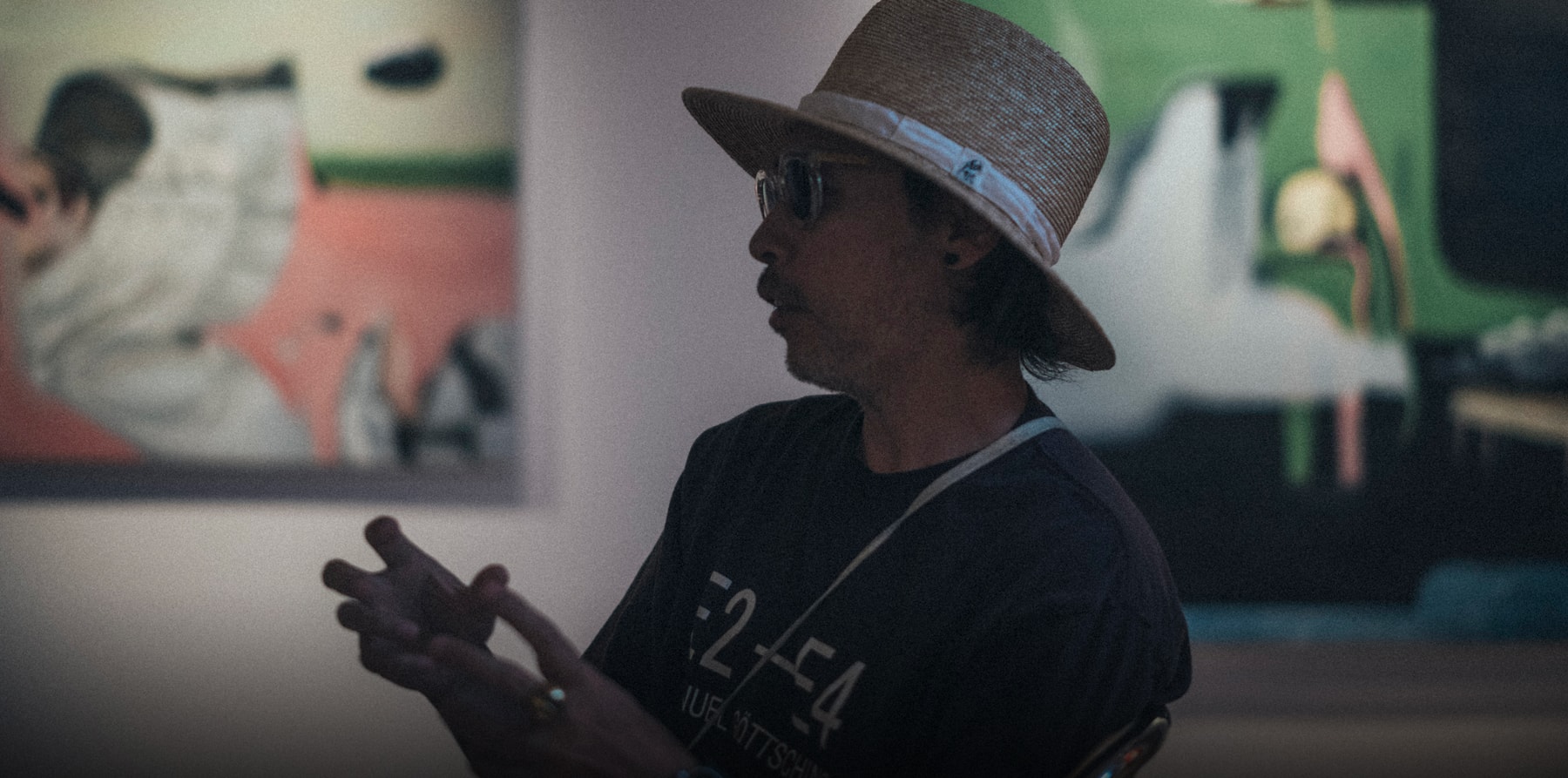

This article originally appeared as the cover story of ‘Hypebeast Magazine Issue 32: The Fever Issue.’ Please visit HBX to grab your copy.
This past August, Tokyo’s GALLERY TARGET adopted a distinct, punkish aura. Its walls were adorned with 26 enigmatic oil paintings depicting canonical characters from literature and pop culture, all of whom were indistinguishable due to the absence of their usual starry eyes. Aside from one portrait that noticeably resembled David Bowie (the subject’s tall coiffed hair giving strong clues), the canvases maintained their ambiguity, even as onlookers moved closer to the frame. Revered Japanese musicians Utada Hikaru and Yumi Matsutoya lent their idiosyncratic vocals to the room, while the eyeless portraits left those with pupils intrigued. This was the opening for Jun Takahashi’s first-ever solo exhibition, THEY CAN SEE MORE THAN YOU CAN SEE, and each piece was sold, well, in the blink of an eye.
Takahashi was not formally known as a studio artist until recently; most would identify him as the Japanese streetwear pioneer behind UNDERCOVER, the insurgent brand he founded over 30 years ago. Those close to the designer, however, have long known of his affinity for the arts. “Since I was a child, I used to draw and doodle whenever I had free time,” he tells us. His inaugural exhibition was an extension of that youthful passion, but it’s a practice that he’s refined over the past decade while moonlighting outside his design work.
Now, with the curtain to his painting career officially lifted, Takahashi is embracing a new chapter and seeking to cement a legacy in a medium that has quietly consumed his downtime for many years. “Sometimes, I spend all day painting in my atelier near the sea,” he says. “Sometimes, I wake up early in the morning and start drawing right away. I usually draw until the evening. Drawing is like stress relief for me.” His practice is grounding and underscores his identity as a creative polymath. Still, Takahashi has never viewed his canvases as a business endeavor.
UNDERCOVER, like its designer, can be defined by extreme dichotomies. Speaking with System Magazine in 2018, Takahashi called himself “normal on the outside, alien on the inside.” For instance, UNDERCOVER’s Fall 2018 show, “The Perks of Being a Wallflower,” commented on the tumult and bliss of teenage adolescence through the contrast of upbeat, Americana-influenced school uniforms and metallic, dark-minded formalwear. (Its soundtrack was in alignment, spanning Paul Anka’s feel-good tunes to Julee Cruise’s somber ballads.)
UNDERCOVER’s mantra of making “noise, not clothes” has long served as the backbone of the brand’s identity. Spring 2015’s homage to rock band Joy Division, Fall 2016’s references to British mod culture, and Spring 2016’s tribute to David Lynch indicate the diversity of Takahashi’s subcultural explorations, while Spring 2010’s crossover with German industrial designer Dieter Rams and Spring 2024’s interpretations of Helen Verhoeven’s paintings articulated the brand’s penchant for artistic collaborations. Takahashi is the chief mastermind behind UNDERCOVER’s entire operation: he is the designer, the illustrator, the writer, the stylist, the music supervisor, and everything in between. More than a fashion impresario, Takahashi is a world-builder, and his curatorial instincts lend themselves seamlessly to painting.
GALLERY TARGET’s exhibition notes emphasize that his art was “originally just a hobby” and that it was “never meant for public presentation.” In fact, the artist himself equates his practice to a soothing decompressant from the intensities that come from leading one of fashion’s most renowned labels. Like his design work, Takahashi’s paintings are rooted in paradox: As his technique steadily improved through practice, he found himself dissatisfied with his on-the-nose depictions of pop culture icons. Instead, he opted to obscure the eyes of each subject, masking their identities.
“Sometimes, I spend all day painting in my atelier near the sea.”
Masks, in the literal sense, are impossible to ignore in Takahashi’s work at UNDERCOVER, too. His Spring 2011 collection introduced the fictitious anti-hero “Underman,” concealed under a Daft Punk-like helmet. Fall 2017 opened with a pandemic-preceding facemask reading “Brainwashed Generation.” It’s clear that his paintings are driven by the same intentional mystique that informs his approach to crafting clothes. But, in the words of Jean Paul Gaultier, “fashion is not art.” And while that statement might incite debate for some, Takahashi concurs: “Fashion and art are completely different things.” For the Japanese savant, art is a purer form of creative expression, “because you can complete it all by yourself from start to finish.” Fashion, he says, is “built on teamwork.”
Though Takahashi independently established UNDERCOVER while he was studying design at Tokyo’s Bunka Fashion College in 1990, it was collaboration that initially positioned his brand across the fashion cognoscenti’s radar. In school, the budding designer formed a friendship with NIGO, who would later achieve global acclaim for his pioneering cult label, A Bathing Ape (BAPE). Both of their passion projects turned professional in 1993 when they opened NOWHERE, the beloved Tokyo store that initially served as an outpost for early-days BAPE and UNDERCOVER apparel, before becoming a fundamental pillar in Japan’s Ura-Harajuku (or “hidden” Harajuku) streetwear circle.
Three decades later, NOWHERE only exists in faded photographs. Takahashi’s brand has evolved into a globally influential enterprise, and he’s begun familiarizing the world with his studio art. Still, even with the abundant success he’s enjoyed, Takahashi affirms the importance of teamwork and the loyalty that fuels its longevity. “I had dinner with NIGO last night,” he says. “The relationship hasn’t changed [over the course of 33 years]. I think that means we’ve both remained pure.”
Art, however, is Takahashi’s solo mission, and his subversive palette can be attributed to the anti-establishment ethos that defined UNDERCOVER’s formative years.
The invitations to Takahashi’s first-ever Paris Fashion Week show for Spring 2003, titled “Scab,” emphasized the brand’s ongoing commitment to breaking the status quo and raising eyebrows. The flier pictured a woman’s neatly-crossed legs, but one knee was plagued with gnarly injuries outlined in dried-up blood and crusted over with intricate clots. Here, Takahashi juxtaposed feminine beauty with the unabashedly grotesque, and the collection that followed became the first to include the designer’s defining slash-and-burn style, which mirrored a similar tension. The line’s frayed hems, undone strings, stripped patchwork, and trailing tassels were gorgeously mangled. With the mutilated silhouettes and flawed finishes, Takahashi made his point: fashion contains multitudes. It’s a discipline that can be equal parts chaotic and controlled, and the trick is to be purposeful when embracing mayhem.
His artwork submits to this doctrine, as well, with two-dimensional portraits of blind figures that somehow still seem to meet the viewer’s gaze. Adorned with experimental markings, scrawled text, and waxy finishes, Takahashi’s paintings, much like his clothes, are both intimate and eerie.
“Searching for new things is like breathing for me.”
Over the past 15 years, Nike, fragment design, and UNIQLO have all tapped the designer to lend his expertise; as has Supreme, who in 2015 established a collaborative relationship with Takahashi that resulted in lawless streetwear with phrases like “ANARCHY IS THE KEY” on leather jackets, “GENERATION FUCK YOU” on MA-1 bombers, and Public Enemy-inspired graphic puffers. While perhaps overlooked during its release, Takahashi’s passion for the arts also came into focus through a 2019 team-up with the acclaimed American photographer Cindy Sherman. A Valentino collaboration that same year, which drew inspiration from Stanley Kubrick’s A Clockwork Orange (1971), lent cinematic themes to Takahashi’s flying saucer motifs and the Italian house’s storied tailoring, ultimately pushing UNDERCOVER into fashion’s upper echelon.
The brand’s elaborate identity and standards adhere to the expectations of streetwear and sportswear, haute couture and casual wear, without skirting a cohesive vision. “High fashion, streetwear, and athleticwear—they have evenly influenced me fashion-wise,” Takahashi says. “All those different elements are all the same in me. So what I create is a remix of them.” Outside of this medley, Takahashi’s zeal for sartorial mingling extends further than traditional subcategories; he infuses other creative practices, like sculpture and music composition, into his projects, pushing the limits of his “designer” title.
There’s always been an unorthodox, distorted interpretation of what’s aesthetically pleasing in Takahashi’s work, and he notes there’s an “eccentric beauty” to his eyeless paintings, too. For example, he’s careful to adorn his idolic subjects with silk curtains on their frames in a delicate, almost loving gesture. The paintings’ blurred finishes are consistent with his attraction to the incomplete, offering a tasteful interpretation of what GALLERY TARGET calls his “closed-off worldview.” Where Takahashi’s UNDERCOVER predominantly references infamous cultural staples, like Aflred Hitchock’s film portfolio, Pink Floyd’s The Dark Side of the Moon album, and, most recently, the wailing banshees of Irish folklore (which trickle into Spring 2024’s designs through melancholic prints and a grim color palette), his paintings also call on real pop culture sources.
Still, the characters and public figures spotlighted in Takahashi’s artworks are much more difficult to decipher. His debut paintings depict “musicians and actors who have had a significant impact on his life,” but the tightlipped artist leaves it at that. “Some things can only be seen in darkness, disappearing in brightness,” reads the exhibition notes. This philosophy not only articulates the sentiment behind Takahashi’s brushstrokes, but also the concurrent thread that weaves through his garments at UNDERCOVER each season. Art as a medium for creative expression, however, is more interpretative in nature, and that’s exciting for Takahashi, who has never been a fan of tying things up in a bow. “We’re human beings—perfection is not cool,” he famously once said.
Two words—“chaos” and “balance”—often land on UNDERCOVER’s apparel, and their divergent themes apply seamlessly to Takahashi’s canvases. It was the designer’s clutch on these two polar words that offered him the limitless potential to exceed in fashion, but it’s his multidisciplinary approach to design that now lets his artistic vision transcend beyond the confines of clothing. While his resume could confidently seat him at any fashion table, Takahashi’s shift into the arts is indicative of his present-day priorities, albeit ones that have been a long time coming.
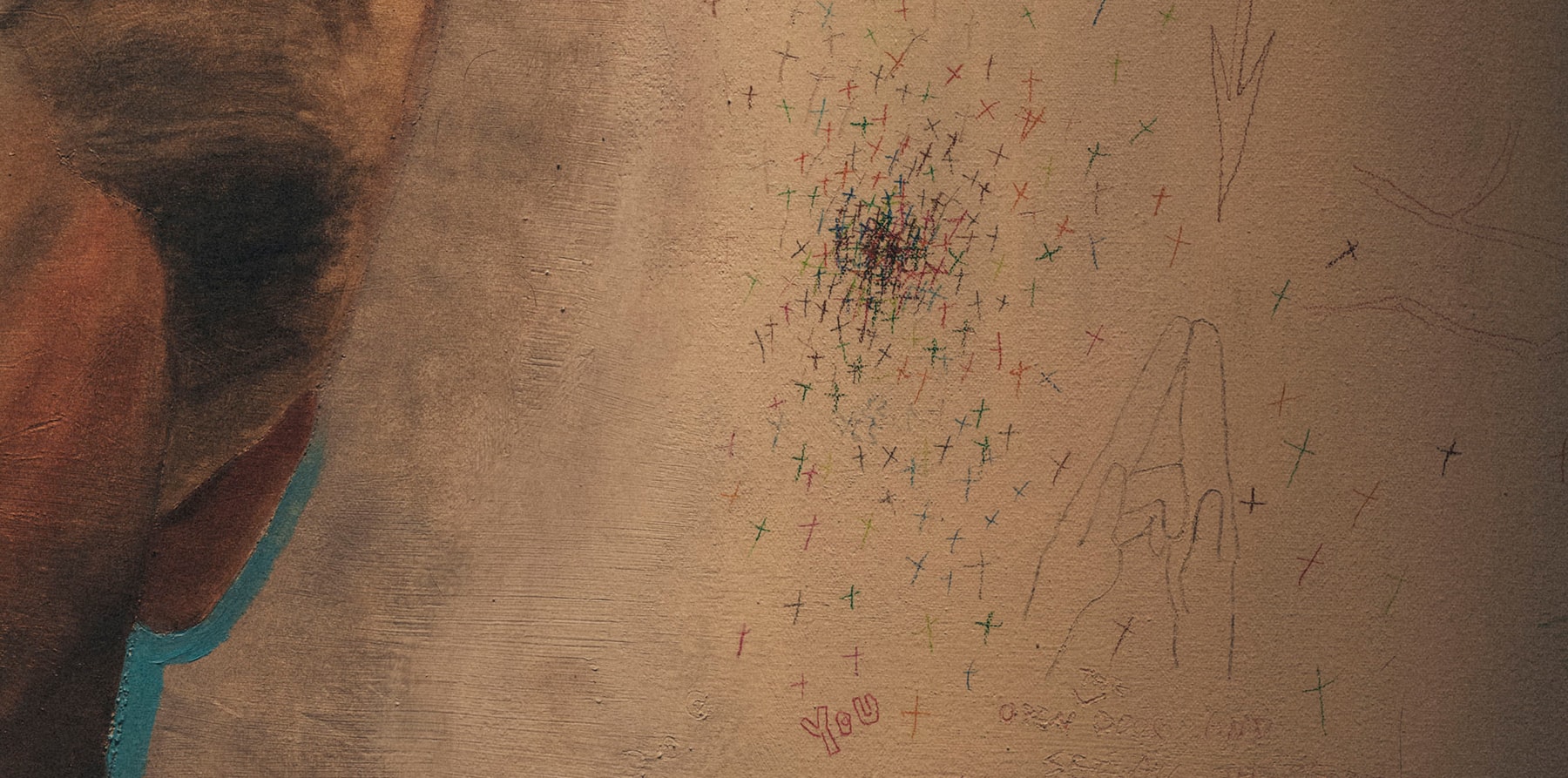
“One thing I can say is [that I’ll be following] my intuition.”
“I’ve reached the age of counting backward,” the 53-year-old now says. Perhaps, it’s this perspective that propelled his decision to introduce his artistic pastimes to the public. After all, his ultimate dream, he says, is “a free life that is not tied to work or money.” Art offers Takahashi a therapeutic transition into his next chapter, one that he’s eager to lean into.
That’s not to say that he will step away from UNDERCOVER. Takahashi’s work ethic remains as poised as ever, but there’s a newfound composure to his outlook that suggests a satisfaction with what he’s already built. “I’m thinking about how to enjoy the rest of my life in my own way,” he says. In pursuit of pleasure, the designer’s mid-life conquest in picking up the paintbrush has come full-circle, seamlessly translating his creative sensibilities from the sewing machine to the easel.
“One thing I can say is [that I’ll be following] my intuition,” he concludes, pondering the future. Never mind the road to what’s forthcoming; it’s his instincts that have always led the way. His sixth sense is fervorous, and where there’s passion, there’s breakthrough. That is, if you’re Jun Takahashi.
All artwork by Jun Takahashi for Hypebeast Magazine. Photos courtesy of Taro Mizutani and GALLERY TARGET.




